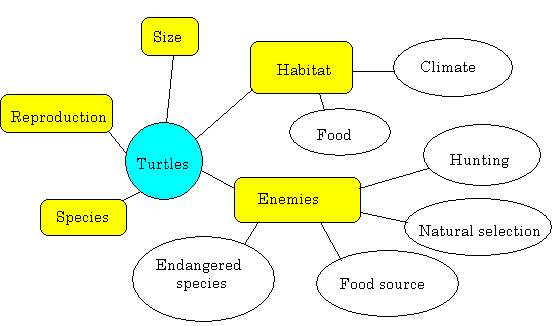
Focusing is the best way to get started on an assignment or project. Sometimes your first idea is either too broad or too specific. You need to pick a focus so that you can gather enough information, but not so much that you get lost in a mass of material.
What about this topic do you want to find out? Be specific.
Example: Turtles
After generating some questions about the topic and doing some background reading, gather different sub-topics together.
Example:

Example:

Stating your topic as a question is a good way to focus your search for information.
Example:
What effects does the environment of the endangered red bellied turtle in Massachusetts have on its survival and what are some possible ways to prevent this species from becoming extinct?
Use the question above and the web above that to write the research questions that will guide your project. Underline the main ideas/words/concepts to use in your search for more detailed information
Example:
Questions to guide the project:
1. Overview information / statistics / definitions
Example: what are the facts about the turtle's habitat, and what statistics exist about its survival?
2. Background / causes / reasons
Example: what conditions in the turtle's habitat could be endangering its existence?
3. Effects / solutions / recommended changes
Example: what could be done to improve the turtle's chance for survival?
The outline becomes the guide for the rest of your work. The outline can be modified, depending on how much information you find on each sub topic.
Example:
I. Topic (Turtles)
A. Sub topic (Species)
1. Detail (Fresh water)
2. Detail (Salt water)
B. Sub topic (Size)
1. Detail (Weight)
2. Detail (Length)
C. Sub topic (Enemies)
1. Detail (Hunting)
2. Detail (Natural selection)
3. Detail (Food source)
4. Detail (Endangered species)
D. Sub topic (Habitat)
1. Detail (Climate)
2. Detail ....etc....
Return to Keeley Library Course Resources
Last Updated: May 25, 2014